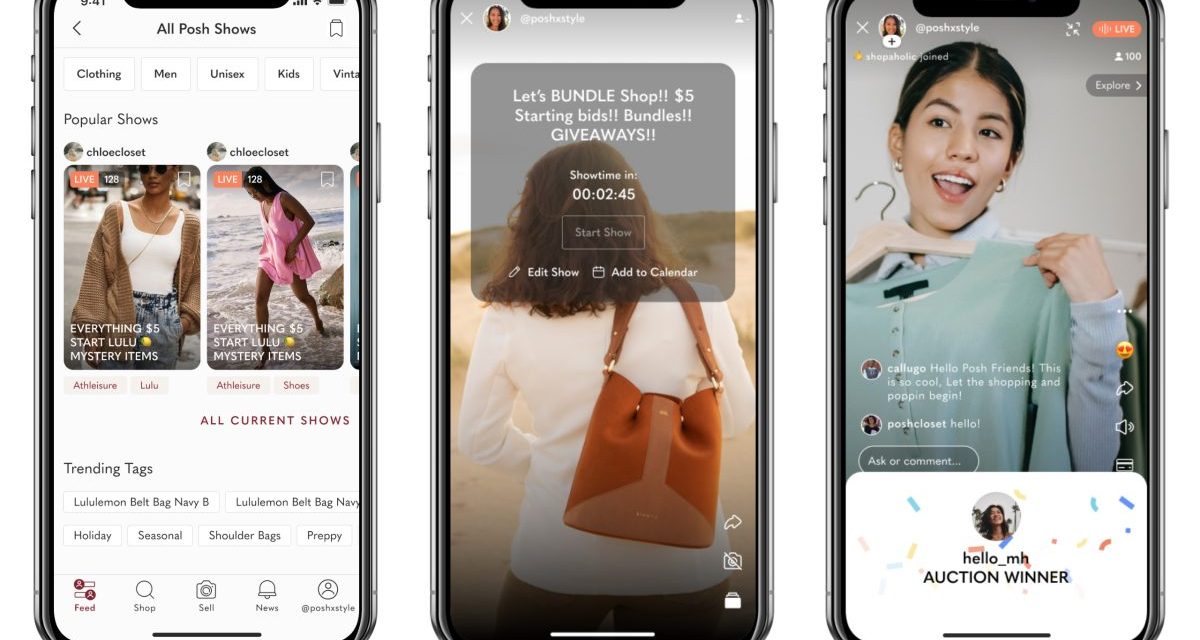How marketplaces like Poshmark & Shein are growing their live shopping platforms

While many brands and platforms have walked back on their livestreaming initiatives, marketplaces like Poshmark and Shein continue to charge forward.
At the recent Modern Retail Commerce Summit in New Orleans, Poshmark CMO Steven Tristan Young and Shein’s head of content creation Marisa Runyon discussed how livestreaming became a critical part of their businesses. Both companies spoke about the investments they made to improve adoption, such as developing new livestreaming features and in-house content production teams.
Three years after the pandemic drove brands to test out live shopping, many have since slowed down investments or given up on the channel entirely. Tech giant Meta, for example, shut down its live shopping feature on Facebook and Instagram. Still, Poshmark and Shein argue that live shopping still has room to grow in the U.S.
“Even though live shopping here hasn’t been what people thought it was going to be in terms of gangbusters. I think it takes time,” Young said. “This is the new QVC. People want to engage online. People are on their phones.”
Poshmark officially launched its live shopping feature, dubbed Posh Shows, in April last year. Already, the company has seen widespread adoption from both the sellers and the buyers. With sellers holding hundreds of shows per day, Poshmark has garnered over a billion minutes of people watching Posh Shows since launch.
A similar success story is taking place at Shein. Shein Live debuted in the U.S. back in 2016 and started with just a few hundred viewers. When Runyon joined Shein in 2022 to lead content production and drive further growth for the fast fashion giant’s livestream feature, the company built its own in-house content production team. Now, “hundreds of thousands of viewers” watch Shein’s live shows on a regular basis, she said.
“Asia is five to 10 years ahead of us with what they’re doing with livestream shopping,” she said. “With just a few hundred viewers and a very low production value type of situation, [Shein] started the show. It continued to grow organically.”
While the two marketplaces are both heavily invested in live shopping, they’re approaching it in ways that are unique to their own platforms. Runyon said Shein wanted to create content at the same pace it produces new products, and livestreaming had been the perfect medium for it.
“The pace in which we drop products is so rapid that the content strategy has to keep up with that pace,” Runyon said. Shein also has a team of core hosts but has also tapped actress Teala Dunn, podcast host Jenicka Lopez and various influencers to participate in the shows.
Poshmark, on the other hand, allows all its sellers to host shows. The company said it has hosted webinars and in-person events for sellers to improve their chops in hosting livestreams. Poshmark also allows sellers to host an auction format as well as a traditional shoppable livestream.
Additionally, while Shein has invested in the production value of its livestreams, Poshmark has been working on adding more tools to allow sellers to host shows in whichever format they prefer. Poshmark recently introduced a co-hosting option for sellers to hold shopping events together. Sellers who aren’t comfortable hosting live shows can also tap other people to live sell their products for them — a feature that Young said the company wants to build on.
Poshmark also said it is rolling out new live shopping features in the coming months.
“We want to be the place where you can sell everything you want,” Young said. “We’re coming up with more ways for you to sell so that no matter what you’re comfortable with, whether it’s being behind a webpage, being behind the camera or working with someone else, we want to create more ways for people to make money.”

